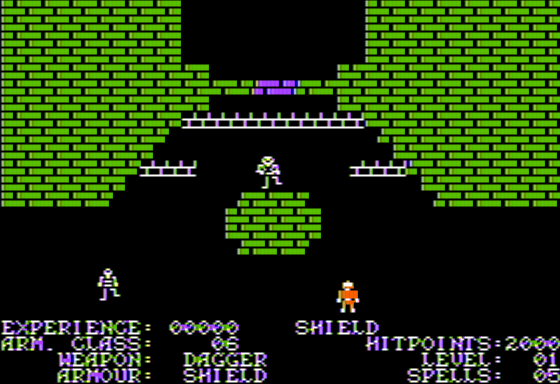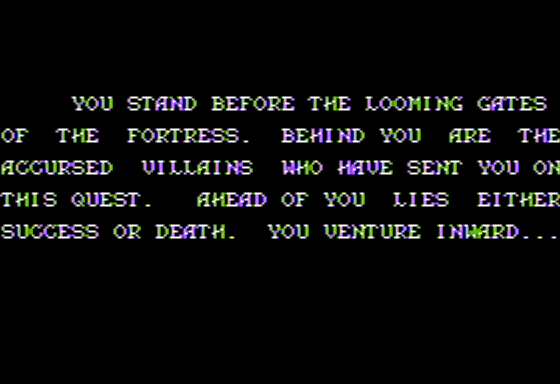Sword of Kadash is an early action RPG, created by Chris Cole and one of the very first releases from Dynamix. Dynamix was behind many classic games such as Project: Firestart, MechWarrior, Stellar 7, the Aces war simulation series, Red Baron, and Rise of the Dragon, among numerous others. Almost none of their games are fantasy-themed, however, so Dynamix likely won't be coming up again here.
Like many PC games of the time, it has an arcade sensibility, similar to something like Berzerk, but with just a bit extra to hopefully interest players beyond recognizing algorithms and honing reflexes. The player controls the hero from a top-down view, attempting to navigate a huge maze one screen at a time. The player can pick up different weapons but despite whatever the weapons are identified as, the combat always takes the form of firing arrows across the screen at enemies. Among the threats you face are various types of wildlife, the undead, orcs, and a liche, among others.
The maze is always the same, but it's full of devious traps beyond the creatures inhabiting it, so progress is best made by mapping or memorizing the layout and noting how the traps work and which items are safe to pick up, so the player can gradually work out the most efficient path through. It's a tough but engrossing game.
The story explained in the manual is that your character is a merchant traveling to Persia to do business, but your guide sneaks off with all your merchandise and provisions, leaving you to die in the desert. Fortunately (?) a band of brigands appears and takes you captive. The leader forces you to enter the Fortress of the Dragon to recover the fabled Sword of Kadash or die trying. You're sent in with "a dagger, a shield, and your natural charm." Assuming you actually succeed, your now hardened hero emerges with the sword with the intent on turning it against the brigands instead of peacefully handing it over.
Cole told the CRPG Addict that he envisioned the game as having more a high fantasy theme, but that the publishers forced the Middle Eastern/historical fantasy theme on him late in development. It's possible a high fantasy theme may have improved sales - this was the mid-80s, when things were shifting toward epics - but for the purposes of this blog, the game's final theme is actually much more in line with classic sword-and-sorcery. A lone adventurer exploring a haunted fortress in the middle of the Persian desert and dealing with brigands sounds like the kind of premise Robert E. Howard could have used for a yarn featuring Conan, El Borak, or maybe Cormac Fitzgeoffrey.
[Apologies for very slow upload pace in recent months. Real life concerns have been incessant, but there's no lack of things to talk about.]






